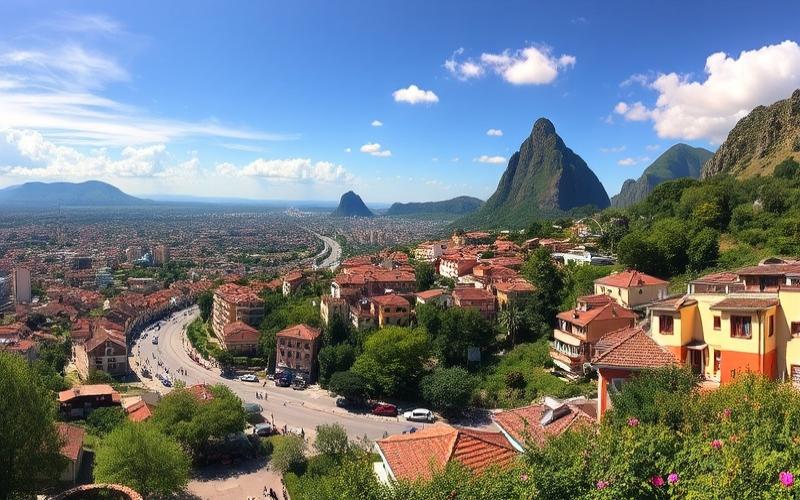
 Published on and written by Cyril Jarnias
Published on and written by Cyril Jarnias
Brazilian Real Estate: The Rise of Co-Living Spaces
The Brazilian real estate market is undergoing a fascinating transformation with the rise of co-living spaces, an innovative concept that’s attracting increasing numbers of young professionals and creatives seeking alternatives to traditional housing.
These shared spaces, typically featuring common amenities like collaborative work areas, shared kitchens, and recreational facilities, address growing demand for more flexible, community-oriented lifestyles in major cities such as São Paulo and Rio de Janeiro.
Good to Know:
Co-living is particularly popular among millennials and digital nomads, who prioritize social experiences and flexibility.
As real estate prices continue to climb, co-living is emerging as an attractive solution for those seeking to balance quality of life with limited budgets, and this trend is having significant implications for Brazil’s traditional real estate market, with developers adapting to meet this new demand.
Economic drivers include rising real estate costs in urban centers, labor market volatility, and efforts to optimize underutilized assets, prompting property owners and operators to offer shared spaces (co-living, coworking) to improve occupancy rates and lower entry costs for users.
On the social and cultural front, significant socio-spatial inequality and urban segregation are driving shared formats that promise access, diversity, and cost-controlled services, while responding to a younger urban culture that’s more mobile and less attached to property ownership.
Major demographic trends include rapid urbanization, metropolitan growth, and concentration of skilled jobs in large cities, increasing pressure on housing and office space, and enhancing the appeal of flexible, shared solutions near employment hubs.
In São Paulo, adoption is pronounced due to higher job and education density, a history of urban fronts linked to economic development, and real estate markets where sharing enables proximity to central areas despite high land costs.
In Rio de Janeiro, metropolitan growth and intra-urban disparities have fueled the rise of shared models, particularly around innovation hubs and well-connected areas, to offset housing costs and reduce commute distances.
Technology (management platforms, keyless access, usage-based billing, social networks) facilitates connections, dynamic pricing, and community building, making modular co-living and coworking models viable at scale.
Lifestyles of young professionals and students favor contract flexibility, mobility between neighborhoods and cities, access to integrated services (Wi-Fi, common areas, events), and social connections that value interest-based communities over individual ownership.
Public initiatives and regulatory frameworks in metropolitan areas have sought to guide urban growth and land use, which, combined with historical land pressure from economic and agricultural cycles, has indirectly favored more space-intensive solutions like shared models.
Challenges include adapting urban planning and safety regulations to hybrid models (housing + services), protecting tenants from contract instability, aligning with affordable housing policies, and integrating into a segmented, unequal traditional real estate market.
Key Highlights:
- Rapid urbanization and metropolitan growth → pressure on rents and land → rise of co-living/coworking.
- Socio-spatial inequalities → demand for affordable, well-located options.
- Technology and platforms → lower transaction costs, large-scale community management.
- Young workers/students → preference for flexibility, short-term contracts, included services.
- São Paulo and Rio → pioneering markets due to job/education density and high costs.
- Public policy challenge → updating standards, aligning with social housing, preventing neighborhood gentrification.
Comparative Table — Metropolitan Dynamics
| City | Key Factors | Impact on Shared Spaces | Challenges |
|---|---|---|---|
| São Paulo | Economic centrality, high land costs, legacy of growth fronts | Strong adoption of coworking/co-living near job hubs | Regulation of mixed uses, accessibility |
| Rio de Janeiro | Metropolitan growth, intra-urban disparities | Shared solutions to reduce costs/distance | Social cohesion, integration into existing fabric |
Operational Levers for Integration:
- Clarify mixed-use categories and habitability/safety standards.
- Encourage public-private partnerships for affordable co-living near transit.
- Implement safeguards against evictions and opaque contracts.
- Monitor impact on neighborhood rents to prevent displacement effects.
Shared spaces in Brazil are developing at the intersection of urban economic pressures, demographic shifts, and technological innovations, with São Paulo and Rio as major testing grounds, but their sustainability will depend on nuanced regulation and their ability to reduce urban access inequalities.
Good to Know:
The rise of shared spaces in Brazil, particularly in major cities like São Paulo and Rio de Janeiro, is driven by several economic, social, and cultural factors. Rapid urbanization and high real estate costs have pushed many young professionals and students to seek flexible, affordable housing solutions, boosting co-living’s popularity. This trend is further amplified by new technologies that facilitate communication and management of these spaces, meeting expectations for flexibility and community. Government policies aimed at modernizing the real estate market, such as tax incentives for new construction, have also supported this model. However, challenges remain, particularly regarding legislation and integration into the traditional market, requiring clearer regulatory frameworks to sustain this type of housing solution.
The Success of Premium Co-Living Among Young People
Young Brazilians are turning to premium co-living because it combines strong cost optimization with superior quality living environments, while enhancing social connections and networking capital essential to their career trajectories.
Main Economic Reasons
- Sharing rents, utilities (water, electricity, high-speed internet), and subscriptions (gym, streaming), reducing total cost per person.
- “All-inclusive” model limiting unexpected expenses and facilitating monthly budget management.
- Contract flexibility (shorter terms, shared deposits) compared to traditional individual rentals, useful for young people moving between cities (São Paulo, Rio, Belo Horizonte).
- Access to central neighborhoods otherwise unaffordable alone, maximizing access to jobs and urban services.
Social and Professional Reasons
- Structured community life: events, workshops, shared dinners, facilitating newcomer integration and reducing isolation.
- Networking among young professionals in dynamic sectors (technology, design, finance), creating opportunities (referrals, projects, freelancing).
- Codified governance and living rules that reduce friction compared to “traditional” co-living (charters, mediation, internal apps).
Cost Reduction vs Quality Offered
- Optimized private spaces (studios, suites) and extensive common areas: professional kitchens, coworking, meeting rooms, rooftops, fitness centers, industrial laundries.
- Included services: common area cleaning, maintenance, 24/7 security, concierge, sometimes wellness (yoga, gym) and micro-mobility (bikes, scooters).
- Operator economies of scale enabling better pricing on services and utilities while maintaining premium amenities.
Role of Community and Social Networks
- WhatsApp/Telegram groups and registration platforms facilitate affinity matching, reducing entry friction.
- Social proof via Instagram/TikTok and open house events, creating reputation and belonging effects valued by young professionals.
- Ambassador programs and internal sponsorship, accelerating occupancy and retention.
Iconic Brazilian Examples and Young Professional Perceptions
- São Paulo: premium co-living projects near innovation hubs (Avenida Faria Lima, Vila Olímpia, Pinheiros) attract tech/fintech profiles for office-coworking proximity and amenity quality.
- Rio de Janeiro: locations in well-connected areas (Botafogo, Flamengo) with emphasis on outdoor spaces and active social life, perceived as “curated communities” rather than mere housing.
- Belo Horizonte/Curitiba/Florianópolis: hybrid formats (co-living + coworking) focused on creative economy and remote work, seen as career and quality-of-life springboards.
- Dominant perception among young professionals: “pay-per-use + network effect” — paying slightly more than basic co-living but accessing service packages, optimal locations, and useful networks.
Recent Statistics on Premium Co-Living Supply and Demand
- Supply growth in major metros (São Paulo, Rio) driven by 20-35 year old demand, hybrid work growth, and flexibility seeking.
- High occupancy rates in premium projects, with shorter turnover cycles and waiting lists during tech/finance hiring peaks.
- Development of “build-to-rent co-living” formats by local and international funds, signaling professionalization of supply.
Comparative Table: Premium Co-Living vs Traditional Rental
| Criterion | Premium Co-Living | Traditional Rental |
|---|---|---|
| Monthly Costs | Shared, predictable (all-inclusive) | Variable, separate utilities |
| Flexibility | High (short terms, mobility) | Lower (12+ month leases) |
| Quality/Services | Premium amenities + services | Property-dependent, limited services |
| Network/Community | Structured and active | Low to informal |
| Central Neighborhood Access | More accessible via sharing | Prohibitive cost alone |
Future Implications for Brazilian Real Estate Market
- Professionalization and standardization: rise of specialized operators, standard contracts, shared satisfaction and occupancy metrics with investors.
- Urban reconfiguration: “qualitative” densification near job hubs, pressure on central land, conversion of commercial buildings to co-living.
- New financial products: dedicated vehicles (local FII/REITs) focused on “living-as-a-service,” increased foreign capital appetite.
- Regulation and compliance: need for clear framework (safety, taxation, occupant rights) to support expansion without quality degradation.
- Inter-segment competition: stimulation of traditional rental market toward furnished units and à la carte services to retain young professionals.
- Sustainability and ESG: energy retrofits, resource sharing, carbon footprint reporting as asset differentiators.
Points of Attention
- Avoid uncontrolled gentrification: integrate affordable unit quotas and municipal partnerships.
- Maintain privacy/community balance: adapted spatial design (soundproofing, micro-suites, calibrated spaces).
- Model sustainability: adjust pricing/occupancy during economic downturns and rising interest rates.
Metrics to Monitor
- Occupancy rates, churn, average stay duration, NPS.
- Services/rent ratio, total cost per occupant vs individual studio in equivalent area.
- Project pipeline in central areas, asset conversions, build-to-rent share.
- Municipal policies on dense living, mobility, and functional mix.
Young people choose premium co-living for the cost-quality-network trade-off: paying controlled rent to access premium locations, professional services, and immediately available social capital, making it a structuring vector of “living-as-a-service” in Brazilian metropolises.
Good to Know:
Premium co-living is experiencing growing success among young Brazilians, attracted by the possibility of sharing housing costs while benefiting from superior facilities such as coworking spaces, gyms, and pools. Iconic projects like WeLive and Housi attract many young professionals, offering not only luxurious living environments but also dynamic communities where social networks play a central role. Recent statistics show a 25% increase in supply and demand for these co-living spaces. This lifestyle reduces costs while fostering exchange and conviviality, crucial elements for a connected, cosmopolitan generation. As this trend develops, it could restructure the Brazilian real estate market, encouraging developers to offer more shared, flexible housing solutions adapted to young urbanites’ new lifestyles.
Co-living spaces in Brazil are redefining urban sociability by combining residential privacy with orchestrated collective living, particularly attracting young professionals, digital nomads, and expatriates seeking immediate networks and simplified logistics. These hybrid habitats offer private rooms with bathrooms and shared spaces (kitchens, lounges, coworking, gyms), structuring daily life where encounters and collaboration become facilitated, recurring practices.
Key Community Dynamics
- Programming of common activities: coworking sessions, skill workshops, language classes, themed parties, and urban outings, fostering weak then strong ties among residents.
- Daily rituals: shared meals, morning “stand-up coffee” to synchronize needs and availability, group workouts, establishing a sense of belonging.
- Profile diversity: students, young professionals, remote workers, and nomads, generating professional support, co-learning, and project opportunities.
Tools and Digital Integration Serving the Community
- Residential management apps: group messaging for coordination (announcements, maintenance, events), common space reservations, activity programming polls, and newcomer welcome channels to accelerate community onboarding.
- Professional infrastructure: “coworking-grade” high-speed wifi, dedicated workspaces, and remote-work-focused event calendars, reducing friction between work and social life.
- Discovery and matching platforms: curation services that select community-oriented co-livings and highlight houses where social animation and sharing values are explicit.
- On-site implementation examples: villages and residences combining accommodation, common areas, and activity schedules for remote workers (e.g., suites or apartments with collective spaces, terraces, meeting spots, organized to foster structured social life).
Why This Digital Community Increases Attractiveness
- For young professionals: optimized total cost (furnished room, included utilities), immediate belonging to a local network, mentorship and collaboration opportunities, and simplified big-city living logistics.
- For expatriates and nomads: reduced isolation, rapid integration into international community, event programming, and practical support (local procedures, urban orientation), with internet quality and spaces adapted to remote work.
- Perceived value: the collective experience becomes a decisive competitive advantage over traditional rentals, where access to community, services, and activities is limited.
Typical Digital Usage Examples in Brazilian Co-Livings
- Resident discussion groups for: daily announcements, carpooling, meal and workshop organization, skill exchanges, minor conflict management.
- Online booking tools: meeting rooms, phone booths, kitchens, and terraces, to avoid congestion and maintain shared experience quality.
- Participatory calendars: activity voting (hikes, surfing, cultural outings), “skill-share” cycles, and project “demo days.”
- Digital onboarding: welcome guides, community living charters, and “buddy systems” for new residents, visible on dedicated platforms.
Challenges and Points of Caution
- Privacy: information circulation in collective groups, involuntary exposure of routines and preferences, need for clear policies on photos/videos in common areas.
- Individual autonomy: implicit social pressure to participate in activities, risk of relational overload, difficulty reserving solitude time in highly animated spaces.
- Governance and moderation: need for explicit rules on digital channel usage, conflict resolution, and space sharing (noise, cleanliness, occupancy), with maintenance ticketing tools.
- Resource access equity: contention for meeting rooms and bandwidth; implementation of quota systems, “quiet hours,” and usage hierarchies tied to professional work.
- Work/personal boundaries: online meetings in living spaces, call confidentiality, data security on shared networks, and wifi best practices.
Summary Table: Attractiveness vs. Challenges
| Dimension | What Attracts | What Raises Questions |
|---|---|---|
| Community | Immediate network, mutual support, programmed activities | Participation pressure, social fatigue |
| Work | Coworking spaces, reliable wifi, simple reservations | Room usage conflicts, call confidentiality |
| Setup | Furnished, utilities included, digital onboarding | Rule standardization potentially limiting autonomy |
| Local Integration | Profile mixing, events and discoveries | Information access inequalities if digitally disconnected |
In short, the digital community – via messaging, shared reservations, and calendars backed by spaces designed for communal living – makes Brazilian co-livings places where people live and work “with” others, both online and in person, while imposing new governance practices and privacy protections.
Good to Know:
The rise of co-living spaces in Brazil is reinventing cohabitation by promoting strong digital communities. These spaces, often equipped with technologies like dedicated mobile apps and online platforms, facilitate event organization and encourage resident interactions. Particularly attractive to young professionals and expatriates, they enable development of personal and professional networks while sharing convivial moments, both online and in person. However, this hyper-connectivity raises privacy and independence questions, requiring balance between sharing and private space respect. For example, some co-living apps include functions for booking common spaces and managing intra-community communications, but must also ensure user data protection.
Disclaimer: The information provided on this website is for informational purposes only and does not constitute financial, legal, or professional advice. We encourage you to consult qualified experts before making any investment, real estate, or expatriation decisions. Although we strive to maintain up-to-date and accurate information, we do not guarantee the completeness, accuracy, or timeliness of the proposed content. As investment and expatriation involve risks, we disclaim any liability for potential losses or damages arising from the use of this site. Your use of this site confirms your acceptance of these terms and your understanding of the associated risks.






















































